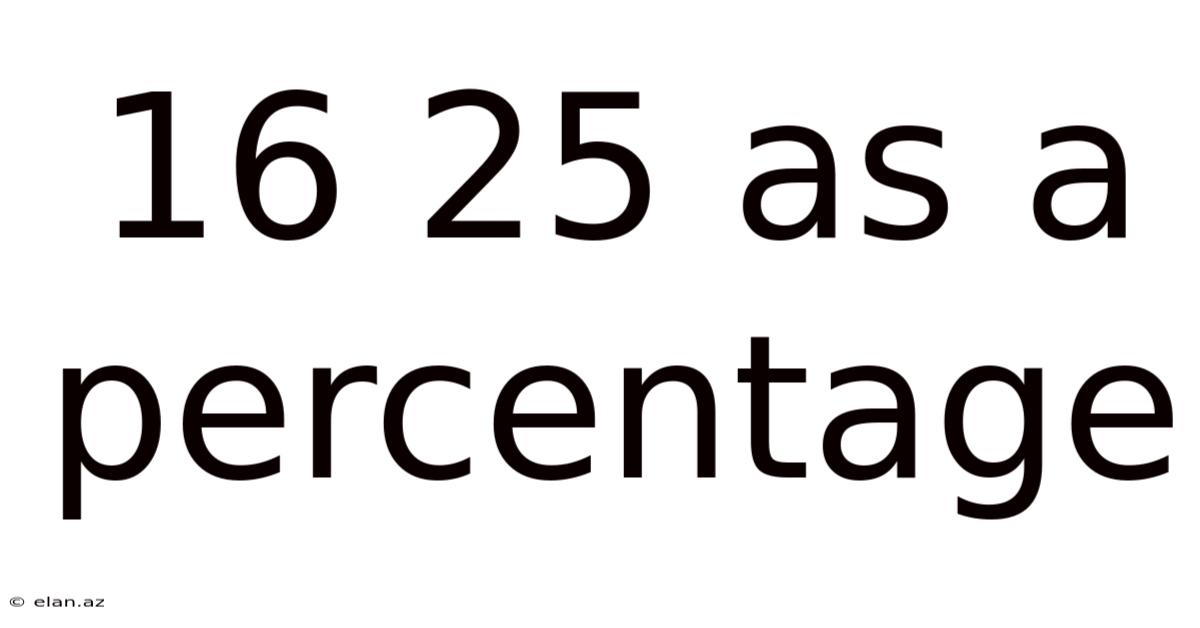16 25 As A Percentage
elan
Sep 14, 2025 · 4 min read

Table of Contents
Decoding 16/25 as a Percentage: A Comprehensive Guide
Understanding percentages is a fundamental skill in various aspects of life, from calculating discounts and taxes to interpreting data and analyzing performance. This article delves deep into the conversion of fractions to percentages, specifically addressing the question: what is 16 out of 25 as a percentage? We'll not only provide the answer but also explore the underlying mathematical concepts, offer practical applications, and address frequently asked questions. This comprehensive guide will equip you with a solid understanding of percentage calculations, ensuring you can confidently tackle similar problems in the future.
Understanding Fractions and Percentages
Before diving into the specifics of 16/25, let's refresh our understanding of fractions and percentages. A fraction represents a part of a whole. It consists of a numerator (the top number) and a denominator (the bottom number). For example, in the fraction 16/25, 16 represents the part and 25 represents the whole.
A percentage, denoted by the symbol %, represents a fraction of 100. It indicates how many parts out of 100 make up a whole. For instance, 50% means 50 out of 100, which is equivalent to the fraction 50/100 or 1/2.
Converting 16/25 to a Percentage
To convert the fraction 16/25 to a percentage, we need to find an equivalent fraction with a denominator of 100. We can achieve this by setting up a proportion:
16/25 = x/100
To solve for 'x', we can cross-multiply:
25x = 16 * 100
25x = 1600
x = 1600 / 25
x = 64
Therefore, 16/25 is equal to 64/100, which is equivalent to 64%.
Alternatively, a more direct method involves converting the fraction to a decimal first. Divide the numerator (16) by the denominator (25):
16 ÷ 25 = 0.64
Then, multiply the decimal by 100 to express it as a percentage:
0.64 * 100 = 64%
Both methods yield the same result: 16 out of 25 is 64%.
Practical Applications of Percentage Calculations
Understanding percentage calculations is crucial in numerous real-world scenarios. Here are a few examples:
-
Calculating Discounts: If a store offers a 20% discount on an item priced at $100, the discount amount is 20% of $100, which is $20. The final price would be $80.
-
Determining Grades: In many educational systems, final grades are expressed as percentages. If a student scores 16 out of 25 on a quiz, their score is 64%, as we've calculated.
-
Analyzing Financial Data: Percentages are essential for understanding financial reports. For example, profit margins, interest rates, and growth rates are often expressed as percentages.
-
Interpreting Surveys and Polls: Results from surveys and polls are frequently presented as percentages to represent the proportion of respondents who selected a particular option.
-
Understanding Statistics: Percentages play a significant role in statistical analysis, helping to interpret data and draw conclusions from large datasets.
Different Ways to Express 64%
While 64% is the most common way to represent 16/25, it can also be expressed in other equivalent forms:
- Decimal: 0.64
- Fraction: 16/25 (the original fraction), 32/50, 64/100 (all simplified to 16/25)
- Ratio: 16:25, 32:50, 64:100 (all represent the same proportion)
Further Exploring Percentage Calculations
Let's explore a few related percentage calculations to solidify your understanding:
Example 1: What is 20% of 75?
To find 20% of 75, we multiply 75 by 0.20 (which is the decimal equivalent of 20%):
75 * 0.20 = 15
Therefore, 20% of 75 is 15.
Example 2: What percentage is 12 out of 30?
First, we form the fraction 12/30. Then we convert it to a decimal:
12 ÷ 30 = 0.40
Finally, we multiply by 100 to get the percentage:
0.40 * 100 = 40%
So, 12 out of 30 is 40%.
Frequently Asked Questions (FAQ)
Q1: Can I use a calculator to convert fractions to percentages?
A1: Yes, most calculators have a percentage function or can perform the necessary division and multiplication to convert fractions to percentages.
Q2: What if the denominator isn't easily divisible to get 100?
A2: You can still use the division method. Divide the numerator by the denominator, and then multiply the resulting decimal by 100 to obtain the percentage.
Q3: Are there any online tools to help with percentage calculations?
A3: Yes, many websites and apps offer online percentage calculators that can handle various percentage-related calculations.
Q4: Why are percentages important?
A4: Percentages provide a standardized way to compare proportions and make relative comparisons easier to understand and interpret. They are widely used across various fields to represent data, make decisions, and communicate information effectively.
Conclusion
Converting fractions to percentages is a fundamental mathematical skill with wide-ranging applications. We have demonstrated that 16 out of 25 is equivalent to 64%. By understanding the underlying concepts and practicing different methods, you can confidently handle percentage calculations in various contexts, from everyday situations to more complex analytical tasks. Remember the key steps: convert the fraction to a decimal by dividing the numerator by the denominator, then multiply the decimal by 100 to obtain the percentage. Mastering this skill will greatly enhance your ability to interpret and utilize numerical data effectively.
Latest Posts
Latest Posts
-
2 Vs 4 Stroke Engines
Sep 14, 2025
-
Life Cycle Of The Bees
Sep 14, 2025
-
5 Letter Words Ending El
Sep 14, 2025
-
Lcm Of 3 9 12
Sep 14, 2025
-
Differences Between Migration And Immigration
Sep 14, 2025
Related Post
Thank you for visiting our website which covers about 16 25 As A Percentage . We hope the information provided has been useful to you. Feel free to contact us if you have any questions or need further assistance. See you next time and don't miss to bookmark.